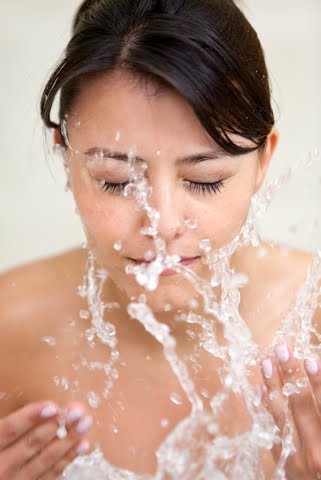
by theglamscientist | | beauty reflections, cleansers, dry skin, hair, shampoo |
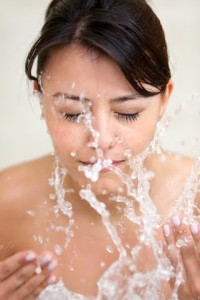
I just spent about 10 minutes in the mirror analyzing my skin… studying it, assessing the flaws and thinking of a master plan to make it perfect. This past week has been a complete disaster in the beauty department. I make no apologies for being vain… and when I say vain, I mean I care a whole lot about my appearance. I want my hair to be perfect and when it’s not it can ruin my day. I want my skin to be clear, soft, pore-less and glowing… when it’s not, I’m nearly depressed. This morning, I sat in deep reflection about skin and hair care from a personal perspective. I thought, “My skin and hair could probably take care of itself if I just let it.” I believe that wholeheartedly.
I stopped using shampoo back in September (6-7 months ago) because I developed a product that cleansed the hair without stripping the natural oils. That was one of the best things I could have done for my hair (and my daughter’s). I was reminded of just how harsh shampoo can be when I decided to use it last weekend and experienced the biggest hair trauma of my life… complete with dramatic tears and sound effects smh. My hair, especially my natural hair, is better off without the suds. I’m beginning to think the same is true for my skin. I’m not willing to eliminate my soap and body wash, but I think it’s time to throw out my facial cleanser and allow my skin take care of itself. Don’t get me wrong, I’m still going to put the good stuff in. I won’t be letting go of my toner, exfoliators or moisturizers. I just think that maybe I’m doing too much by using a cleanser to “clean” my face. How dirty could it be? With using a cleanser I’ve noticed my skin has changed from dry to combination… but not in the typical areas. I don’t have t-zone issues alone, my cheeks may break out too. O_O I NEVER had issues with breakouts before. I also started to see my pores in the smile line area between my nose and mouth. That is not cool at all. Halfway through my skin care bootcamp this past week, I stopped using my cleanser. Instead, I rinsed my face with warm water and used my white tea toner and aloe. My dry patches are clearing and my pores are returning to normal size. From a scientist’s perspective, I think the cleanser may have been throwing off my skin’s natural ability to regulate itself.
This is not to say that I think everyone should throw out their shampoo/cleanser. But as a person with naturally dry skin and hair, I don’t need it. I rarely wear makeup (only eyeliner and mascara when I go out). Nor do I put a lot of product in my hair between washes. Someone that did either may still need to use a little bubble action in their beauty regimen. Just remember, if bubbles are involved, conditioning and moisturizing is not an option, it is a requirement.
What are your beauty reflections? Have you considered changing the way you care for your hair and skin? Tell us about it!
Here’s to the Glam Life!

by theglamscientist | | hair, hair care, hair conditioning, hair damage, hair elasticity, healthy hair |

Elasticity is a very important factor in assessing the strength of hair. The elasticity of the hair is an indicator of what styles and/or processes your hair can withstand. When hair has low elasticity, it will not hold a curl well (thermal or wet styled) and it is more prone to damage caused by styling and chemical treatments. Basically, hair with low elasticity is weak and must be handled with care.
Chemical treatments including relaxers, permanent wave, color and even keratin should be preceded by an elasticity strand test to ensure minimal (ideally zero) breakage occurs. But you should also consider performing an elasticity test before going to wacky with the hooded dryer, blow dryer, round brush and flat iron because this requires good elasticity, too. One way to test your hair’s elasticity is to take a [full length] strand of hair from your comb or brush. Hold the strand with the index finger and thumb of both hands about 2 inches apart. Quickly and firmly pull the strand of hair. If the strand snaps, it has low elasticity; If it remains in tack, it has good elasticity.
Another strand test that is equally as fun is what I call the “ribbon curl” test. Hold a strand of hair between the index finger and thumb of one hand. With the index finger and thumb of the opposite hand, use your thumb nail to firmly run along the length of the strand so that it curls. — This is similar to curling a ribbon with scissors. — Now stretch the curl until the strand is straight then let it go. If the strand returns to the original curl pattern, it has good elasticity. If it returns to at least half the original curl, it has moderate elasticity. If it stays straight, your hair is in bad shape :(.
Many factors affect the elasticity of the hair. Excessive heat styling, combing/brushing when the hair is wet and chemical treatments can all have a devastating effect on your hair’s level of elasticity. If after performing the strand test you find that your hair has low elasticity, avoid all of the above styling faux pas. Hair elasticity can be improved by giving your hair what it lacks… PROTEIN! Hair is 100% protein (keratin). Hair with low elasticity has weaker protein bonds than that of good elasticity. Nevertheless protein treatments are a good idea for everyone sooooo… Run, run, run to your nearest beauty supply to purchase a deep conditioning protein treatment.
Here’s to the Glam Life!
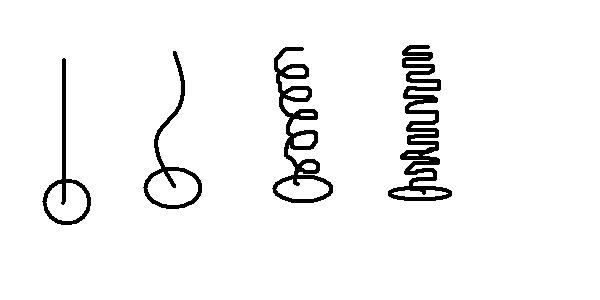
by theglamscientist | | hair, hair follicle, hair texture |
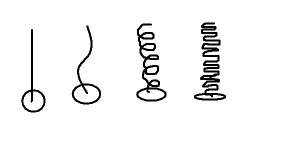
Wednesday evening, I gave a speech entitled “Hair, Hair and More Hair!” at my Toastmasters International club. I covered a lot in that 9min 30sec speech that I have not yet covered here… so, here it goes. 🙂
I’ve always been completely fascinated and intrigued by hair. My mom has maintained her cosmetology license for nearly 30 years, so I grew up a tad more knowledgeable and obsessive about my hair than many other little girls. In addition to working on a hair care line in the lab, I recently decided to make a drastic change in the way that I manage my hair. Enter even more obsessive behavior O_O. As the glam girl in me was reading about various hair textures and styles and treatments, the scientist in me peeked in to ask a few questions. A scientist that has questions cannot rest until they have answers, so you can probably guess how my “research” grew wings.
How does hair get it’s texture?
The texture of any one person’s hair depends on the shape and size of the hair follicle. There are 4 general shapes of a hair follicle which happen to correlate perfectly with Andre Walker’s hair types philosophy. A hair follicle is like a tiny tube that guides the hair to the surface of the scalp. A round hair follicle yields straight hair. The more oval the hair follicle, the more curly the hair it yields.
Similarly, the thickness of hair is dependent on the size of the hair follicle. Large follicles produce thick strands of hair while smaller follicles produce thin strands of hair.
What I really wanted to know was the real science behind hair texture. I was interested in why hair texture differs across and within ethnic groups. Could it be genetic? Hormonal? Due to human adaptation/evolution? Apparently, the type of hair your parents have definitely determines the type of hair you end up with, whether that is straight, wavy or curly. Just last year, a study showed that variants of a particular gene determine how curly your hair will be. Scientists still aren’t clear exactly which variants play a part or how they work.
The fact that some people have hair that changes textures throughout their lifetime hints that hormonal changes may be at work. There are even cases of caucasian people with thick, coarse hair like that of African and African American people. It’s a rare occurrence, but it happens often enough to have a name– “Wooly Hair Syndrome”. Imagine that.
While I’m slightly disappointed that all of my questions were not answered, the research is well on it’s way. I look forward to finding out what factors are at work in determining our hair texture. I hear that the research is being pushed because the findings are a gold mine. There may be a pill developed that could change your hair texture from straight to curly and back straight. My curiosity didn’t take me to that train of thought (that’s bordering on mad scientist territory imo), nevertheless, I find it all muy interesante…
So, what’s your hair texture? Does it change from time to time?
Here’s to the Glam Life!

by theglamscientist | | acidic, alkaline, basic, conditioner, hair, hair care, healthy hair, pH balance, pH test, shampoo |
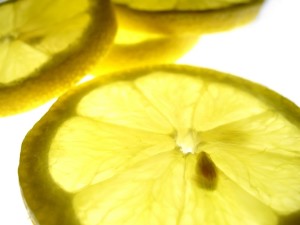
I started a new project in the lab last week that inspired this blog post. While developing new products, a lot of “tests” are done to make sure all is as it should be. One test that is a constant for all (most) products is pH. pH indicates the level of acidity (or basicity pOH) of a substance. pH is important in cosmetic product development because skin and hair have pH too. The products you apply to your skin and hair should work with your body chemistry, not against it.
The pH scale starts at 0 and caps off at 14 with 0 being highly acidic, 14 being highly basic and 7 being neutral (7 is the pH of distilled water). Either end of the scale results in severe chemical burns. The pH of normal, healthy hair ranges from 4.5 to 5.5 (mildly acidic). Similarly, the pH of basic hair care products range between 4 and 6. Color treated and/or damaged hair tends to have a more basic (alkaline) pH. In a basic environment, the cuticle layer of the hair stands out and appears frayed or split. In order to treat damaged hair, a hair product must be more acidic to smooth the cuticle layer resulting in less tangles and higher shine. The process of treating alkaline hair with acidic products is what is meant by “pH balanced”. Knowing that damaged hair has a higher pH indicates that a normal pH hair care product may not be very effective in treating damaged hair.
Putting it all together
I’m sure you’ve noticed that hair care products are marketed for certain hair types ie dry/damaged/split ends, normal, oily, etc. While these products will often use different ingredients to garner results, one key factor is pH. A formulator will know if the product has a chance of working just by taking the pH of the final formula. I have rarely seen the pH of a hair care product disclosed on the packaging. So as the consumer, you need to get a little crafty. Before trying a product, I suggest you pick up your own supply of pH (litmus) paper and do a quick test. The ideal pH would be 4 or 4.5 to work well on all hair types. No matter how damaged your hair may appear, you never want a product with a pH lower than 3– and even that’s pushing it. **Keep in mind, the pH test only works for products/treatments that contain water.
You’re now just a pH test away from gorgeous, healthy hair 😉 Here’s to the Glam Life!








